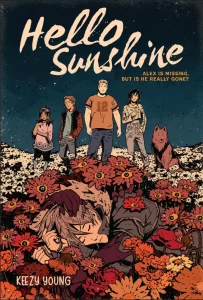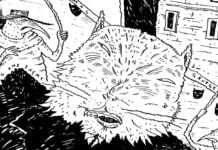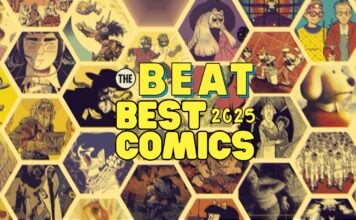 Hello Sunshine
Hello Sunshine
Cartoonist: Keezy Young
Publisher: Little, Brown Ink.
Publication Date: September 2025
On a whim, perhaps because of my rekindled interest in it, I decided to open this with a drawing of a Tarot card. I don’t think a full reading would be apt (not the least of which because it would delay things). But a drawing feels right all the same. This will be the last thing I write before I send the review over to Zack.
My deck is The Urban Tarot. I got it years ago at the first FlameCon I attended. I think Keezy was there, but I don’t recall. It was either in 2019 or 2021. Checking my emails shortly after that sentence, I found a conversation with the lovely Elana Levin confirming it was in 2019. (I haven’t seen her in years and it sounds like she’s doing swimmingly.) I got into Tarot mostly for the art and because a lot of comics people I knew were into magic.Seemed interesting enough and I liked the idea of a deck based around New York City. (That said, I spend way too much at conventions.)
My first reading was in my Senior Year of College, probably in late 2016, early 2017. It was at a Friday Night Fun Event that I mostly missed to play board games. (I made a lot of friends while playing those board games. I wish I kept in contact.) The Tarot reader I met asked for my birthday and noted that my birth card was Death, a symbol for change. I would later (by which I mean earlier this year) look up my birth cards and find my other to be the Emperor.
I have shuffled the deck eight times to make it ready for the drawing. I draw the top card and find Art. The image is of a winged woman painting graffiti on the side of the street. Her art is that of an angel with red wings. Her paint is melting onto the street, feeding the asphalt so that a child’s idea of flowers can grow. (I think they’re daisies, but it might be more thematically apt to lie and say they’re sunflowers.)
I leave it to you, dear reader, to draw your own conclusions.
There is an obvious parallel to be made with Hello Sunshine. It is a parallel that writer/artist Keezy Young themselves made while pitching the book in 2023. Indeed, Young has noted the parallels numerous times throughout discussing the book’s main characters as a base from which they could develop their characters into something more. The jock who sees the best in people, the weird nerdy girl who has to know everything, the fashionista with a heart of gold, a witty fellow who always seems to get into trouble, and their dog.
Other parallels arise from this obvious lens. Historically speaking, there is a long tradition of taking the Mysteries Five format (or, if you want to go even deeper in ur-texts, the Archies) and doing your own spin on the material while barely changing a thing about it. Instead of five kids and a dog, it’s three kids and a shark or teenage Charlie’s Angels and a caveman or a gaggle of Asian stereotypes. At best, you end up with some pretty good music. Even an album’s worth. At worst, God has abandoned you for fear of Scooby-Dum.
On the artistic front, these parallels are highlighted. Character wise, Young has opted for the simplistic designs often seen within Hanna Barbera cartoons that allow for a recognizable silhouette. (Note how Young draws the eyes with a dot and one or two lines surrounding it rather than a more detailed approach. Very much in keeping with Iwao Takamoto and Alex Toth’s design philosophy.) For example, our first viewpoint character, Noah, has a broad shoulder’s and a defensive football player’s physique. By contrast, his asshole friend and fellow footballer, Greyson, has a leaner athletic design, more fit for running back than defense.
A core difference, however, is the approach Hello Sunshine takes to its backgrounds. While not spoken about in most pop culture recollections of the show, the obvious comparison was littered with settings that always felt abandoned. Cobwebs littering shelves, wallpapers peeling and embracing entropy, and a color pallet that evokes the spooky sensibilities of the show. Even locations that were supposedly the homes, towns, or businesses of various people (masked monsters and otherwise) felt as if they had been abandoned by those who lived in there. A gothic road trip across post-’68 America trying to remember that youthful past, only to find ruins and capitalistic greed in its place.
By contrast, there’s a warmth and homeliness to Hello Sunshine. Where the obvious comparison was littered with dark, foreboding colors that made even open businesses feel unnerving, Hello Sunshine feels like any other small town. There’s a warmth and almost nostalgic feel to walking the streets of this Anywhere, USA, despite taking place in the modern day. Even the nighttime sequences within the comic have a coolness to it rather than the coldness that often found itself within one of the most influential television shows of the late 1960s. This has the effect of making some of the truly horrific moments all the more shocking.
One such moment being the title drop. Midway through the third chapter, our characters end up in the age old horror situation of finding a tape recording with the voice of a dead person on it. The scene begins with rather cool blues and limited backgrounds. Panel wise, the page is depicted in a rather controlled nine panel grid of seven panels. The first six panels are standard blocks of rows of three panels while the final panel is a combined row.
Nothing about this breaks with the visual language depicted within the comic so-far. Generally, Young utilizes juxtaposition of moments to highlight tension or connections between characters. An earlier sequence, for example, highlights our various lead characters reacting to supernatural phenomena in a visually parallel format rather than giving each character their own page.
In this sequence, however, the visual language is broken with the addition of an insert panel of the tape recorder, providing us with the title drop. Where previous insert panels would have a white border to highlight the separation (indeed, the very next page has one of the dog, Cass), this one is presented without a border. It is a deliberate intrusion of supernatural forces upon the world. Moreover, the break in visual storytelling is unsettling. It pierces the frame like a dagger through the heart.
Another moment of breaking the visual language comes shortly thereafter, wherein another expected scene in this sort of fiction occurs: the summoning of a ghost. As I mentioned, the character design largely evokes the Hanna Barbera template of simplistic design, especially when it comes to the eyes. However, as our teenage protagonists interact with the ghost, her eyes become more and more detailed. Gaining color and depth — like the shining lights of an oncoming trolly as it approaches its designed problem — disorienting the reader with its wrongness.
A third moment of superb visual storytelling is when a personal secret is made public to the teen’s parents and the fallout therein. The first half of the page is littered with text providing the character’s thoughts and emotions regarding the event. Each chapter, as alluded to before, is seen from the perspective of one of the meddling kids with their own biases and interpretations of the other characters. And then, the narration notes that the character’s parents found out, and things go deathly quiet.
We have seen the implications of what’s happening up to this moment throughout the story so far. But having the levee break in stark silence, the autumnal color pallet acting as a harsh spotlight on the cruelty of the moment. Leading into the isolating blues of night. There is no supernatural aspect to this horror. No ghosts or demons or backwards speaking trees. Just the horror of parents deciding they don’t love their kid as much as their ideal version of their kid. One who isn’t queer.
This further pays off with a flashback later in the story, seen from the point of view of the boyfriend — who is experiencing a simultaneous nervous breakdown and haunting event (which, if one reads up on their Jackson, can be one and the same). In this moment, the boyfriend is forced to be in the most awkward dinner of his life. Where the paneling was before rather straight and narrow in controlled rectangles, the panels in this extended scene of dread, decay, and homophobia tilt onto each other as parallelograms and trapezoids.
Worse, comes the moment when the panels do align with narratively typical rectangles, making up a nice set of nine panel grids, and we see Alex react to how “normal” people think of him when he’s not in the room with them. All those wretched anxieties and words of self-loathing — you could never be loved, everyone’s waiting for the right moment to destroy you, they hate you — become crushingly true and horrifying, even for only a moment.
It is worth bringing in the point of views of the various characters. While the majority of the narrative presents their points of view through the lens of their narration, the boyfriend — Alex — has difficulty expressing his thoughts in words. As such, how his world is presented is frequently through the visuals of what’s happening (fitting, given he’s an artist). As such, the collapse of his mental state (brought about by supernatural and… traditional forces) is presented through the images rather than through the words. Characters lose their coherence, become distorted copies of a copy of a copy of a copy of a copy.
In many regards, it’s the perspective of these characters that provides us with the depth beyond their stock archetypes. Take, for example, Alex’s brother, Jamie. Of all the characters we see throughout the narrative, Jamie is the last one to receive a viewpoint chapter. We can make assumptions about him from the archetype the obvious comparison provides. A slacker. A drug fiend. Witty. Dating a fashionista who is also gay. (Don’t fight me on this one, I have receipts.) But as we see him through the eyes of his friends, details emerge. His wit is acerbic and coarse. He lashes out at people when provoked. He has a tendency of running away when things get too tough.
He left his brother when he needed him the most.
But it’s when we see things from Jamie’s perspective, that we get the full insight into who he is as a person. Each chapter, to some degree or another, is written with the idea that someone will read it. Be it a prayer to God, a set of investigation notes, or clues regarding an occult tragedy. They are meant to reveal as much as they are meant to conceal, even if it’s just from themselves. Their anxieties, their fears, their hopes, their plans. Jamie’s is written to his dead mom, as ordered by his court ordered shrink. He muses about his fears of similarities. How much of himself is in his mother, his father, his messed up family. Is he only capable of hurting people?
But the truth is far more complicated. Not that these are all false, but rather that it’s all true. That the moments when we were cruel, monstrous, evil, anxious are just as much a part of ourselves as the times we were kind, helpful, loving, happy. Hello Sunshine is a comic about taking the seemingly flat archetypes we place onto people and finding the depths therein. It’s about finding the worst part of ourselves and figuring out how to love it anyways. It’s about being in love and that horrid part of you that says it won’t last because of who you are. It’s about demons and witches and things worse than both of them.
It’s about growing up. And fucking up. And trying to make things better. And making things worse. And figuring out a way forward. It’s a love story, it’s a horror story, it’s a tragedy, it’s a comedy. It’s life, in all its messy contradictions of depth and meaning. There aren’t always happy endings, or sad ones, or ones that cohere in ways that make sense to the survivors. And that’s ok. Life is full of mysteries and secrets. Some of us never get to be known beyond our stock archetypes.
And, you know, it’s a pretty good comic.
Some people spend their whole lives
Chasing after dreams
Dreams I guess they never will believe in
Playing foolish games
Inventing fairy tales and schemes
Building fantasies that will deceive them
I don’t need to look around
I’m in heaven since I found my…
–Pretty Mary Sunlight, George A Robertson Jr.
Hello Sunshine will be available in September
And check out the Beat’s most recent comics reviews!















